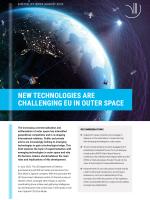New technologies are challenging EU in outer space

- Ongoing EU space initiatives must engage in dialogue on the implications of experimenting with emerging technologies in outer space.
- The EU should enhance its active engagement in established multilateral forums for such dialogue including the UNIDIR Outer Space Security Conference, the UNOOSA World Space Week and the OEWG on Reducing space threats through norms, rules, and principles of responsible behaviours.
- Advancements of such discussions should include a call for enhanced transparency around space endeavours, common understandings of key concepts, and wider discussions on fair regulation, which would enable the EU to support trust building amongst key stakeholders.
In June 2023, The US Department of Defence purchased around 500 terminals and services from Elon Musk´s SpaceX company. With this purchase the US Government obtained control of Internet access in Ukraine, which, amongst other things, is used for coordinating drone strikes and gathering intelligence. Up until that point, this control was in the hands of one man: SpaceX CEO Elon Musk.
The Pentagon purchase is a clear example of the increasing experimentation conducted in a nexus between commercialisation and militarisation. This is just one example in a long line of developments related to outer space in recent years. To address these developments, the European Union (EU), in March 2023, launched the first-of-its-kind EU Space Strategy for Security and Defence (EU Space Strategy). Based on the perception of an increasingly tense and competitive geopolitical reality unfolding in outer space, the Strategy proposes to maximise the use of space for security and defence purposes. It outlines central political and strategic ambitions to protect the EU’s space based assets, strengthen its counterspace capabilities, and solidify its strategic autonomy in the domain. As such, the Space Strategy alongside ongoing efforts to implement an EU Space Law are the most recent in a sequence of EU initiatives acknowledging outer space as a critical driver of global politics, economy, and security.
The strategy comes in the wake of a broader transformation of outer space from a domain for scientific exploration to a crucial arena for international economy and security. Our growing reliance on satellite-based technologies for communication, navigation, and data services means that space forms an integral part of daily life. Moreover, the growing recognition of the military potential of outer space has spurred competition among nations and private companies to achieve technological advancements in satellite systems, launch capabilities, and space-based applications. The increasing commercialisation and militarisation of outer space has intensified geopolitical competition and heightened the importance of space in shaping international relations.
Based on the perception of an increasingly tense geopolitical reality unfolding in outer space, the new EU Strategy proposes to maximise the use of space for security and defence purposes.
Both public and private actors are increasingly looking to emerging technologies to gain a technological edge in outer space. Emerging technologies such as Artificial Intelligence (AI), autonomous systems, and quantum technologies are being adopted into various space programmes for reasons of national security, strategic dominance, and financial opportunity. Though emerging technologies - whose applications on Earth are still actively debated – are said to be economically beneficial and necessary for defence purposes in outer space, they pose critical challenges to the key priorities of EU space engagement as well as ongoing moves to foster legislative change in the domain. The following explores experimentation with emerging technologies in outer space and why EU decision-makers should address the main risks and implications of this development.
Experimenting in the nexus between commercialisation and militarisation
While emerging technologies may offer promising advancements, experimenting with them in outer space introduces significant challenges to the EU’s political and strategic ambitions for space and must be carefully considered in ongoing discussions on space affairs. Emerging technologies in space, just as on Earth, present major unknown unknowns: potential consequences that are unimaginable or unknown to us, so far. This uncertainty means that there is little foundation for comprehending the long-term socio-political, economic, and security implications of experimenting with new technologies in outer space.
Space is no area of exemption from the potential drawbacks of new technologies, quite the contrary. These technologies carry significant security implications for life on Earth when applied to an increasingly contested, congested, and competitive domain. Elon Musk’s Starlink project is a striking example of this.
Outer space, here, becomes the theatre of a significant shift. One in which the growing dominance of private companies empowers them to act within their interests and not their federal government’s. Indeed, Starlink’s rise to power as the main supplier of Internet access in remote areas and areas of war has attracted wide criticism. On the ground, Elon Musk has on several occasions denied the Ukrainian military Internet access, which has been argued to have had direct consequences for their capabilities on the battlefield. In space, SpaceX’s extensive use of AI means that its satellites are able to navigate autonomously from Earth to space and back using AI predictions of the orbits of other satellites and debris to avoid collision. However, over the recent years, SpaceX satellites have been close to colliding with satellites or space debris on several occasions, constituting a threat to other space objects and activities.
Move fast and break things
Limited insight into the implications of emerging technologies is of particular concern when the technologies are applied in a domain of tensing geopolitical rivalry such as outer space.
A general lack of transparency in AI’s decision-making processes, commonly known as the ‘black box’ problem, means that it is difficult to determine how the AI arrives at a specific result or decision. This raises concerns about accountability and the potential biases of AI systems. A mistake in an AI’s identification of potential threats in space could provoke unwarranted reactions and unwanted escalation of conflict.
Public as well as private space actors from SpaceX to the International Space Station (ISS) have set their sights on outer space as a particular domain of opportunity for experimenting with emerging technologies.
AI has become indispensable to space operations because of its ability to process and analyse large volumes of data in real-time. SpaceX has played a pioneering role in the experimentation of AI in outer space. Today, SpaceX uses AI to calculate the orbits of various space objects to pilot their own satellites safely and avoid collision.
The ISS is utilising the weightlessness of outer space to conduct quantum research. The low influence of gravity in outer space, also called microgravity, allows objects and astronauts to float and move with ease. Though this research will not introduce fundamentally new weapons, it is expected to possess highly relevant applications for encryption, intelligence gathering, and military sensor technology.
The global defence industry is also investing heavily in advancing its outer space portfolio. From facilitating lunar landings to designing satellite-based missile detection systems, governments are looking to the private space sector and well-known defence contractors, such as Lockheed Martin, to harvest the newest innovations and test the potential military applications of emerging technologies.
The entrepreneurial slogan “move fast and break things” may encourage disruptive thinking in favour of profit maximisation. However, in space, it is a literal portrayal of the geographic environment and physical conditions of the domain. Even a rock or a small satellite that falls out of orbit can pose a significant threat to other space objects, as it can trigger a cascade of collisions creating vast amounts of debris and rendering future space activities increasingly dangerous. As such, an experimental approach to a common domain could have far-reaching consequences both in space and on Earth.
A domain for future warfighting
The popular perception of space as a domain for future warfighting has seen national military space programmes expressing mounting interest in emerging technologies to boost their military and strategic capacity. This conflicts with one of the central ambitions of the EU Space Strategy: to prevent an arms race in space.
Already now, the US Department of Defence is working on an AI-assisted space-based early warning system for hypersonic missiles as well as a space-based quantum Internet network for cutting-edge encryption. China has voiced its ambitions to develop autonomous space-based laser weapons capable of attacking enemy satellites using AI. And Russia recently announced successful progress in autonomous capabilities for tracking and controlling small space objects.
A lack of shared definitions concerning behaviours in outer space means that there is little foundation for common conduct. While one of the key agreements on space security, the Outer Space Treaty, prohibits the stationing of weapons of mass destruction in space, it does not explicitly ban all forms of militarisation or weaponisation. This leaves room for a liberal interpretation of peaceful activities in space. Plans to implement an EU framework for space regulation constitute an opportunity to advance dialogue between key actors from both public and private entities, including discussions on the opportunities and risks posed by the potential convergence of national security and commercial interests.
Emerging technologies in space present major unknown unknowns: potential consequences that are unimaginable or unknown to us, so far.
Recognising the risks
The current state of space affairs characterised by increased commercialisation and militarisation as well as a growing interest in experimenting with emerging technologies in outer space necessitates new EU space initiatives to effectively address the risks resulting from emerging technologies. Though the EU Space Strategy speaks of utilising new technology for defence and strategic purposes in outer space, it gives little consideration to the risks posed by the significant technological developments unfolding in the domain.
Forthcoming legislative and regulatory developments in the EU should prioritise the shaping and strengthening of existing engagements on responsible behaviour around emerging technologies in outer space. To this end, the EU could benefit from utilising the convening power of the United Nations (UN) and enhance its engagement herein through, e.g., the annual Outer Space Security Conference facilitated by the UN Institute for Disarmament Research (UNIDIR), the World Space Week by the UN Office for Outer Space Affairs (UNOOSA), and the Open-Ended Working Group (OEWG) on Reducing space threats through norms, rules, and principles of responsible behaviours. Advancements of these discussions could include a call for enhanced transparency around ambitions as a space actor and intentions behind space activities, common clarity around key concepts, and wider discussions on fair regulation.
However strategically and militarily advantageous, current technological developments risk accelerating an already rapid race for technological superiority in the highly congested and fiercely contested domain of outer space. Applying emerging technologies in space, of which we have little understanding or experience back on Earth, can extensively undermine not only European but international security.
DIIS Experts


